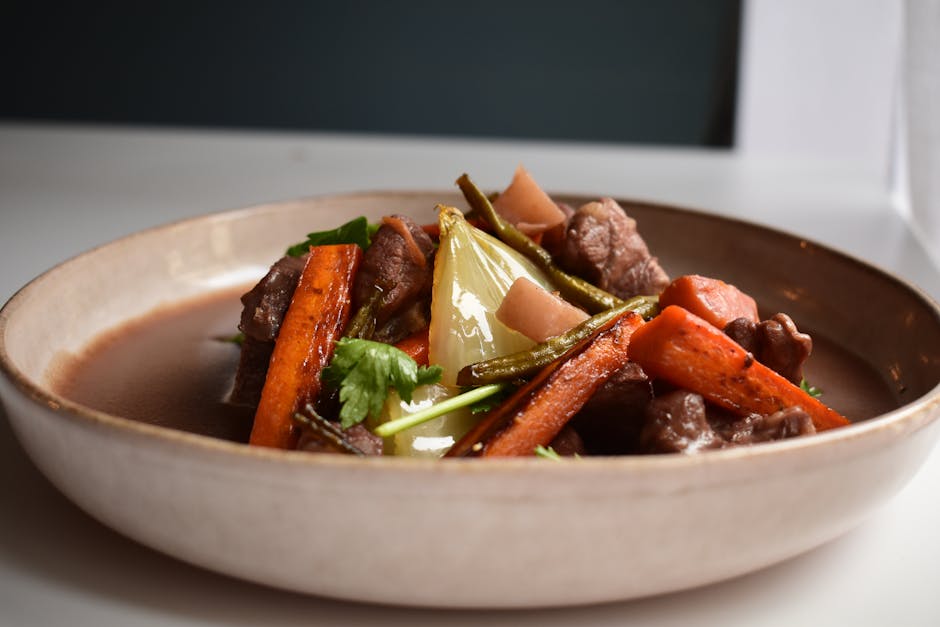Craving a taste of home? Let’s dive into a hearty and flavorful Filipino favorite – Beef Mechado! This tender beef stew, simmered in a rich tomato sauce with potatoes and other veggies, is pure comfort food. It’s a dish that brings back memories and creates new ones with every bite. Get ready to learn how to make this classic Filipino dish that’s sure to become a family favorite.
What is Beef Mechado? A Filipino Culinary Staple
Beef Mechado is a classic Filipino beef stew characterized by its rich tomato-based sauce, tender beef cubes, and a medley of vegetables. The term “Mechado” comes from the Spanish word “mechar,” which means “to lard.” Traditionally, the beef is larded with pork fat to add flavor and moisture, although this technique is less common today. This dish is a perfect example of the fusion of Filipino and Spanish culinary influences. Imagine tender beef, bursting with savory flavors, nestled amongst soft potatoes and other vibrant vegetables – that’s the magic of Mechado!

Why You’ll Love This Recipe
There are tons of reasons to adore Beef Mechado. First, it’s incredibly flavorful and satisfying. The beef becomes incredibly tender during the slow cooking process, and the sauce is packed with umami and depth. It’s also a very versatile dish. You can easily customize the vegetables and seasonings to suit your preferences. And, let’s be honest, who can resist a good comfort food stew?
- Tender Beef: The beef is cooked until melt-in-your-mouth tender.
- Rich and Flavorful Sauce: The tomato-based sauce is the heart of the dish.
- Versatile and Adaptable: Easily customize the ingredients.
- Comfort Food Classic: A perfect dish for a cozy night in.

Making the Perfect Beef Mechado: Step-by-Step Guide
Now for the fun part – let’s get cooking! Here’s a detailed breakdown of how to make Beef Mechado from scratch:
Gathering Your Ingredients
First, you’ll need to assemble your ingredients. Here’s what you’ll need to make a delicious batch of Beef Mechado:
- Beef: Chuck roast is ideal, cut into 1-inch cubes.
- Soy Sauce: Adds umami and depth.
- Calamansi Juice (or Lemon Juice): Provides acidity to tenderize the beef and brighten the flavors.
- Garlic and Onion: Aromatics are essential for a flavorful base.
- Tomato Sauce and Tomato Paste: Create the rich tomato-based sauce.
- Potatoes: A classic addition to Mechado.
- Carrots: Adds sweetness and texture.
- Bell Peppers: (Optional) Adds color and a slightly sweet flavor.
- Green Peas: (Optional) Adds a touch of freshness.
- Bay Leaf: Adds a subtle aromatic flavor.
- Black Peppercorns: Adds a touch of spice.
- Cooking Oil: For searing the beef.
- Water or Beef Broth: For simmering.

The Cooking Process: A Detailed Walkthrough
- Marinate the Beef: In a bowl, combine the beef cubes with soy sauce and calamansi juice (or lemon juice). Marinate for at least 30 minutes, or ideally, up to overnight in the refrigerator.
- Sear the Beef: Heat cooking oil in a large pot or Dutch oven over medium-high heat. Sear the beef in batches until browned on all sides. Remove the beef and set aside.
- Sauté the Aromatics: In the same pot, sauté the garlic and onion until fragrant and softened.
- Build the Sauce: Add the tomato sauce and tomato paste to the pot. Cook for a few minutes, stirring occasionally, to reduce the acidity of the tomato paste.
- Combine and Simmer: Return the seared beef to the pot. Add water or beef broth, bay leaf, and black peppercorns. Bring to a simmer, then reduce heat to low, cover, and cook for about 1.5-2 hours, or until the beef is very tender.
- Add the Vegetables: Add the potatoes and carrots to the pot. If using, add bell peppers and green peas as well. Cook until the vegetables are tender, about 20-30 minutes more.
- Adjust Seasoning and Serve: Taste and adjust seasoning with salt and pepper as needed. Serve hot with steamed rice.

Tips for Achieving the Best Beef Mechado
Want to take your Beef Mechado to the next level? Here are some tips to keep in mind:
- Use Quality Beef: Choose a cut of beef that’s well-marbled for maximum flavor and tenderness. Chuck roast is a great option.
- Don’t Skip the Marinating: Marinating the beef not only adds flavor but also helps to tenderize it.
- Sear the Beef Properly: Searing the beef adds a delicious crust and locks in the juices. Make sure your pot is hot enough and sear in batches to avoid overcrowding.
- Simmer Low and Slow: Patience is key when making Beef Mechado. Simmering the stew over low heat for a long time will result in the most tender beef and flavorful sauce.
- Customize the Vegetables: Feel free to add or substitute vegetables according to your preference. Some popular additions include green peas, bell peppers, and even hot dogs.

Serving and Storing Your Beef Mechado
Once your Beef Mechado is ready, it’s time to serve it up! Traditionally, Beef Mechado is served hot with a generous serving of steamed white rice. The rice soaks up the delicious sauce, making every bite a flavorful experience.
Serving Suggestions
- Serve with steamed white rice.
- Garnish with chopped green onions or parsley.
- A side of pickled vegetables (atchara) can add a refreshing contrast.
Storing Leftovers
Leftover Beef Mechado can be stored in an airtight container in the refrigerator for up to 3-4 days. It can also be frozen for longer storage. Reheat gently on the stovetop or in the microwave before serving. In fact, many people find that the flavors of Beef Mechado actually improve after a day or two in the refrigerator, as the flavors have more time to meld together!

Conclusion: Enjoy the Authentic Taste of Filipino Beef Mechado
So there you have it – a complete guide to making delicious and authentic Filipino Beef Mechado! With its tender beef, rich tomato sauce, and comforting vegetables, this dish is sure to become a new favorite in your household. Don’t be afraid to experiment with the vegetables and seasonings to create your own unique version. Now, gather your ingredients, put on your apron, and get ready to enjoy a taste of Filipino culinary tradition. Happy cooking!
